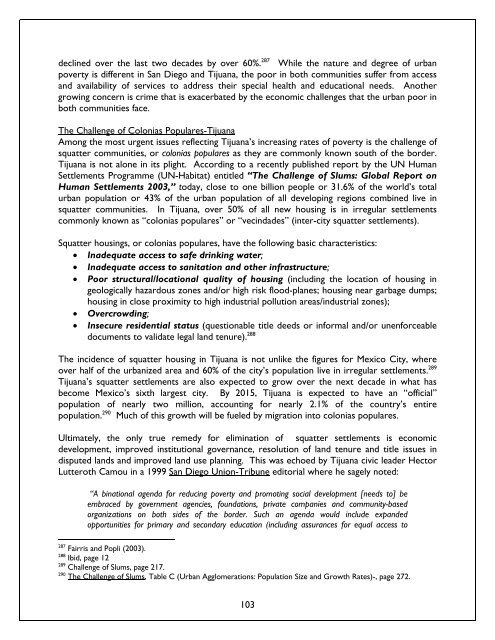Blurred Borders - International Community Foundation
Blurred Borders - International Community Foundation
Blurred Borders - International Community Foundation
Create successful ePaper yourself
Turn your PDF publications into a flip-book with our unique Google optimized e-Paper software.
declined over the last two decades by over 60%. 287 While the nature and degree of urban<br />
poverty is different in San Diego and Tijuana, the poor in both communities suffer from access<br />
and availability of services to address their special health and educational needs. Another<br />
growing concern is crime that is exacerbated by the economic challenges that the urban poor in<br />
both communities face.<br />
The Challenge of Colonias Populares-Tijuana<br />
Among the most urgent issues reflecting Tijuana’s increasing rates of poverty is the challenge of<br />
squatter communities, or colonias populares as they are commonly known south of the border.<br />
Tijuana is not alone in its plight. According to a recently published report by the UN Human<br />
Settlements Programme (UN-Habitat) entitled “The Challenge of Slums: Global Report on<br />
Human Settlements 2003,” today, close to one billion people or 31.6% of the world’s total<br />
urban population or 43% of the urban population of all developing regions combined live in<br />
squatter communities. In Tijuana, over 50% of all new housing is in irregular settlements<br />
commonly known as “colonias populares” or “vecindades” (inter-city squatter settlements).<br />
Squatter housings, or colonias populares, have the following basic characteristics:<br />
• Inadequate access to safe drinking water;<br />
• Inadequate access to sanitation and other infrastructure;<br />
• Poor structural/locational quality of housing (including the location of housing in<br />
geologically hazardous zones and/or high risk flood-planes; housing near garbage dumps;<br />
housing in close proximity to high industrial pollution areas/industrial zones);<br />
• Overcrowding;<br />
• Insecure residential status (questionable title deeds or informal and/or unenforceable<br />
documents to validate legal land tenure). 288<br />
The incidence of squatter housing in Tijuana is not unlike the figures for Mexico City, where<br />
over half of the urbanized area and 60% of the city’s population live in irregular settlements. 289<br />
Tijuana’s squatter settlements are also expected to grow over the next decade in what has<br />
become Mexico’s sixth largest city. By 2015, Tijuana is expected to have an “official”<br />
population of nearly two million, accounting for nearly 2.1% of the country’s entire<br />
population. 290 Much of this growth will be fueled by migration into colonias populares.<br />
Ultimately, the only true remedy for elimination of squatter settlements is economic<br />
development, improved institutional governance, resolution of land tenure and title issues in<br />
disputed lands and improved land use planning. This was echoed by Tijuana civic leader Hector<br />
Lutteroth Camou in a 1999 San Diego Union-Tribune editorial where he sagely noted:<br />
“A binational agenda for reducing poverty and promoting social development [needs to] be<br />
embraced by government agencies, foundations, private companies and community-based<br />
organizations on both sides of the border. Such an agenda would include expanded<br />
opportunities for primary and secondary education (including assurances for equal access to<br />
287 Fairris and Popli (2003).<br />
288 Ibid, page 12<br />
289 Challenge of Slums, page 217.<br />
290 The Challenge of Slums, Table C (Urban Agglomerations: Population Size and Growth Rates)-, page 272.<br />
103















